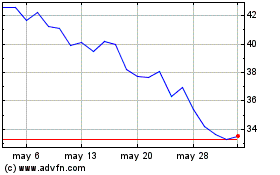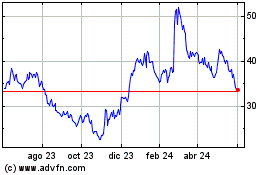Celldex Therapeutics Presents Positive Topline Results from Barzolvolimab Phase 2 Study in Chronic Inducible Urticaria
29 Julio 2024 - 3:01PM

Celldex Therapeutics, Inc. (NASDAQ:CLDX) announced today positive
topline results from the Company’s Phase 2 clinical trial of
barzolvolimab in two of the most common forms of chronic inducible
urticaria (CIndU)—cold urticaria (ColdU) and symptomatic
dermographism (SD). The study includes patients who remain
symptomatic despite treatment with antihistamines. Barzolvolimab is
a humanized monoclonal antibody that specifically binds the
receptor tyrosine kinase KIT with high specificity and potently
inhibits its activity, which is required for mast cell function and
survival. CIndU is characterized by the occurrence of hives or
wheals that have an attributable trigger associated with
them—exposure to cold temperatures in ColdU and scratching/rubbing
of the skin in SD. Mast cell activation is known to be a critical
driver in ColdU and SD.
“Barzolvolimab is the first drug in development to demonstrate
statistically significant and clinically meaningful results in a
large, randomized, placebo-controlled study in chronic inducible
urticaria. These data are unprecedented and clearly demonstrate
that barzolvolimab has the potential to become a critically needed
new treatment option for patients suffering from this disease,”
said Anthony S. Marucci, President and Chief Executive Officer of
Celldex Therapeutics. “Inducible urticaria is a disease of misery
for patients who despite their best efforts often find it
impossible to avoid their disease triggers and are impacted by
severe itching and burning hives that dramatically impact all
aspects of their lives. We look forward to advancing barzolvolimab
into registrational studies in inducible urticaria and moving
towards our goal of bringing this potential new medicine to
patients. We would like to thank the patients and investigators who
participated in this study and look forward to presenting the full
12 week data from this study at an upcoming medical meeting in the
fourth quarter of this year.”
Data from the 196 patients randomized in the study showed that
barzolvolimab achieved the primary efficacy endpoint, a
statistically significant difference between the percent of
patients with a negative provocation test compared to placebo at
Week 12 as assessed by the TempTest® in ColdU and the FricTest® in
SD. Importantly, barzolvolimab demonstrated rapid, durable and
clinically meaningful responses in patients with CIndU refractory
to antihistamines. Demographics and baseline disease
characteristics were well balanced across treatment groups.
|
Summary of Clinical Assessments at Week 12 |
|
|
Cold Urticaria |
|
Symptomatic Dermographism |
|
|
150 mg q4w(n=32) |
300 mg q8w(n=32) |
Placebo(n=32) |
150 mg q4w(n=33) |
300 mg q8w(n=33) |
Placebo(n=31) |
|
% of patients with negative provocation test at Week 12 (complete
response) |
46.9%p=0.0023 |
53.1%p=0.0011 |
12.5 |
% |
57.6%p<0.0001 |
42.4%p=0.0003 |
3.2 |
% |
Barzolvolimab was well tolerated with a favorable safety profile
consistent with prior studies. Most adverse events were mild to
moderate in severity; through 12 weeks, the most common treatment
emergent adverse events in barzolvolimab treated patients were hair
color changes (13%) and neutropenia (11%). The rate of infections
was similar between barzolvolimab-treated patients and placebo with
no association between neutropenia and infections.
The Phase 2 study is a randomized, double-blind,
placebo-controlled, parallel group study evaluating the efficacy
and safety profile of two dose regimens of barzolvolimab in
patients with CIndU who remain symptomatic despite antihistamine
therapy. 196 patients in 2 cohorts (differentiated by CIndU
subtype) including 97 patients with ColdU and 99 patients with SD
were randomly assigned on a 1:1:1 ratio to receive subcutaneous
injections of barzolvolimab at 150 mg every 4 weeks, 300 mg every 8
weeks or placebo during a 20-week treatment phase. Patients then
enter a follow-up phase for an additional 24 weeks. The primary
endpoint of the study is the percentage of patients with a negative
provocation test at Week 12 (using TempTest® for ColdU and
FricTest® for SD). Secondary endpoints include safety and other
assessments of clinical activity including CTT (critical
temperature threshold), CFT (critical friction threshold) and
WI-NRS (worst itch numeric rating scale).
For additional information on this trial (NCT05405660), please
visit www.clinicaltrials.gov.
TempTest® and FricTest® are registered trademarks of Moxie
GmbH.
Webcast and Conference CallTo access the live
and archived webcast, please visit the Investor Relations page of
Celldex’s website at https://ir.celldex.com/events-presentations.
Parties interested in participating via telephone may register here
to receive the dial-in numbers and unique PIN to seamlessly access
the call. Otherwise please access the listen-only webcast link. The
archived webcast will be available for a limited time on the
Company’s website.
About Chronic Inducible Urticaria (CIndU)CIndU
is characterized by the occurrence of hives or wheals that have an
attributable trigger associated with them. ColdU symptoms include
itching, burning wheals/hives and angioedema when skin is exposed
to cold temperatures. SD symptoms include the development of wheals
in response to stroking, scratching or rubbing of the skin.
Approximately 0.5% of the total population suffers from chronic
inducible urticarias. For these diseases, mast cell activation
leading to release of soluble mediators is thought to be the
driving mechanism leading to the wheals and other symptoms. There
are currently no approved therapies for chronic inducible
urticarias other than antihistamines and patients attempt to manage
symptoms associated with their disease through avoidance of
triggers.
About BarzolvolimabBarzolvolimab is a humanized
monoclonal antibody that binds the receptor tyrosine kinase KIT
with high specificity and potently inhibits its activity. KIT is
expressed in a variety of cells, including mast cells, which
mediate inflammatory responses such as hypersensitivity and
allergic reactions. KIT signaling controls the differentiation,
tissue recruitment, survival and activity of mast cells. In certain
inflammatory diseases, such as chronic urticaria, mast cell
activation plays a central role in the onset and progression of the
disease. Barzolvolimab is currently being studied in chronic
spontaneous urticaria (CSU), chronic inducible urticaria (CIndU),
prurigo nodularis (PN) and eosinophilic esophagitis (EOE) with
additional indications planned for the future, including atopic
dermatitis (AD).
About Celldex Therapeutics, Inc.Celldex is a
clinical stage biotechnology company leading the science at the
intersection of mast cell biology and the development of
transformative therapeutics for patients. Our pipeline includes
antibody-based therapeutics which have the ability to engage the
human immune system and/or directly affect critical pathways to
improve the lives of patients with severe inflammatory, allergic,
autoimmune and other devastating diseases. Visit
www.celldex.com.
Forward Looking StatementThis release contains
"forward-looking statements" made pursuant to the safe harbor
provisions of the Private Securities Litigation Reform Act of 1995.
These statements are typically preceded by words such as
"believes," "expects," "anticipates," "intends," "will," "may,"
"should," or similar expressions. These forward-looking statements
reflect management's current knowledge, assumptions, judgment and
expectations regarding future performance or events. Although
management believes that the expectations reflected in such
statements are reasonable, they give no assurance that such
expectations will prove to be correct or that those goals will be
achieved, and you should be aware that actual results could differ
materially from those contained in the forward-looking statements.
Forward-looking statements are subject to a number of risks and
uncertainties, including, but not limited to, our ability to
successfully complete research and further development and
commercialization of Company drug candidates, including
barzolvolimab (also referred to as CDX-0159), in current or future
indications; the uncertainties inherent in clinical testing and
accruing patients for clinical trials; our limited experience in
bringing programs through Phase 3 clinical trials; our ability to
manage and successfully complete multiple clinical trials and the
research and development efforts for our multiple products at
varying stages of development; the availability, cost, delivery and
quality of clinical materials produced by our own manufacturing
facility or supplied by contract manufacturers, who may be our sole
source of supply; the timing, cost and uncertainty of obtaining
regulatory approvals; the failure of the market for the Company's
programs to continue to develop; our ability to protect the
Company's intellectual property; the loss of any executive officers
or key personnel or consultants; competition; changes in the
regulatory landscape or the imposition of regulations that affect
the Company's products; our ability to continue to obtain capital
to meet our long-term liquidity needs on acceptable terms, or at
all, including the additional capital which will be necessary to
complete the clinical trials that we have initiated or plan to
initiate; and other factors listed under "Risk Factors" in our
annual report on Form 10-K and quarterly reports on Form 10-Q.
All forward-looking statements are expressly qualified in their
entirety by this cautionary notice. You are cautioned not to place
undue reliance on any forward-looking statements, which speak only
as of the date of this release. We have no obligation, and
expressly disclaim any obligation, to update, revise or correct any
of the forward-looking statements, whether as a result of new
information, future events or otherwise.
Company ContactSarah CavanaughSenior Vice
President, Corporate Affairs & Administration(508)
864-8337scavanaugh@celldex.com
Patrick TillMeru Advisors(484)
788-8560ptill@meruadvisors.com
Celldex Therapeutics (NASDAQ:CLDX)
Gráfica de Acción Histórica
De Jun 2024 a Jul 2024

Celldex Therapeutics (NASDAQ:CLDX)
Gráfica de Acción Histórica
De Jul 2023 a Jul 2024
